Serrated knives are popular and amazing kitchen utensils that offer a unique cutting mechanism that sets them apart from traditional straight-edged blades. This article goes deeply into these efficient utensils explaining their features, advantages, and uses as we explore “What is a serrated knife used for”.
What is a serrated knife: overview
Serrated knives, popular for their distinctive edge, stand out as indispensable tools in every kitchen, these knives are distinguished from other cutleries by their distinctive appearance, their variety of features, and their toothed or saw-like edge. When the question “What is a serrated knife used for” is asked, the first thing that comes to mind is cutting.
The blades of serrated knives are usually made of high-carbon stainless steel, which is known for its strength and ability to withstand corrosion. This particular steel variety gives the knife its durability, preventing the serrations from rapidly dulling even after repeated use.
Some knives may incorporate a combination of carbon and stainless steel like chef’s knives for the best possible balance of strength and resistance to corrosion.

A serrated knife’s teeth, which run along the cutting edge, are what distinguish them from plain-edge knives. These serrations can have scalloped, pointed, or even combination edges, among other patterns, the way these serrations are arranged has a big impact on how well and efficiently the knife cuts.
Bread knives are frequently found with scalloped serrations, they ensure clean slices by gripping the surface of bread crusts without compressing the softer interior. Pointed Serrations feature more aggressive, pointed teeth. Because of their sharp serrated edges, they are excellent at piercing the hard outer skins of fruits and vegetables while still slicing with accuracy.
A serrated knife comes in diverse blade lengths and shapes tailored for specific purposes. Some possess a long blade that is great for slicing large roasts or loaves of bread, while others have shorter, more adaptable blades that are good for simpler tasks like slicing tomatoes.
The cutting mechanism of a serrated blade is different compared with traditional straight-edged knives. Because the serrations’ teeth produce tiny grooves along the cutting edge, they can grip and rip through hard or delicate materials without applying excessive force. Smoother cuts are made possible by this saw-like action, which lessens the need for a back-and-forth motion.
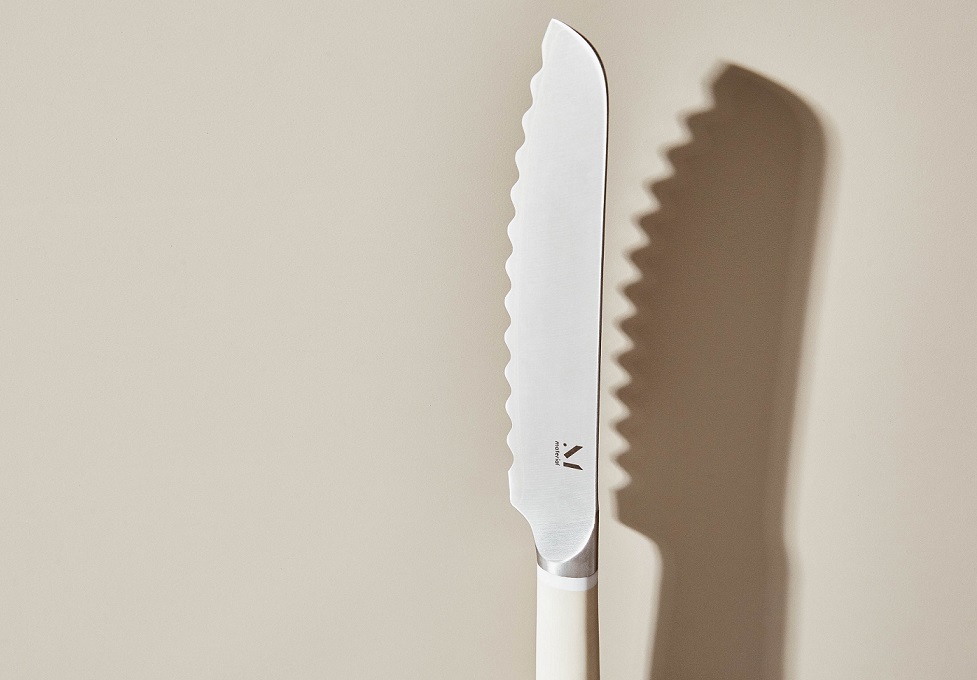
Advantages of serrated knives
- Reduced Friction. The design of a serrated knife greatly lowers friction while cutting. Through the creation of tiny points of contact along the blade, the serrations reduce surface area and facilitate smoother slicing through a variety of textures. This decreased friction helps preserve the integrity of delicate food items like cakes or tomatoes in addition to improving cutting efficiency.
- Edge retention. Because of their narrow blade and tooth design, the serrated knife has exceptionally good and superior edge retention. Compared with traditional straight-edged knives, the serrations allow the blade to sustain its sharpness over extended periods by distributing wear more evenly throughout the blade. This characteristic translates into a longer interval between sharpening sessions.
- Resilience. Another significant advantage is that serrated knives tend to retain their sharpness even with regular use, unlike other kitchen knives that might require frequent honing. The design of the serrated edge minimizes contact with cutting surfaces, reducing wear and tear and preserving the integrity of the blade’s cutting ability.
- Ease of Use. The special cutting mechanism of a serrated knife often requires the user to exert very little effort. Smoother and more precise cutting motions are made possible by the teeth’s ability to grip the surface of the food or object being cut. Because of this feature, a serrated knife is especially good for people who have weak hands.

Functions of a serrated knife
Just like the paring knife and the chef’s knife, serrated knives are very important in every kitchen as they serve several purposes, these purposes are explained below.
Bread slicing
When inquiring about “What is a serrated knife used for” cutting bread is one of the primary functions that comes to mind. The teeth of a serrated knife produce tiny grooves that let the knife cut through crusts while maintaining its soft interior, which makes them perfect as bread knives.
With minimal pressure, this exact grip and cutting action produce clean slices while maintaining the texture and shape of the crusty loaf of bread.
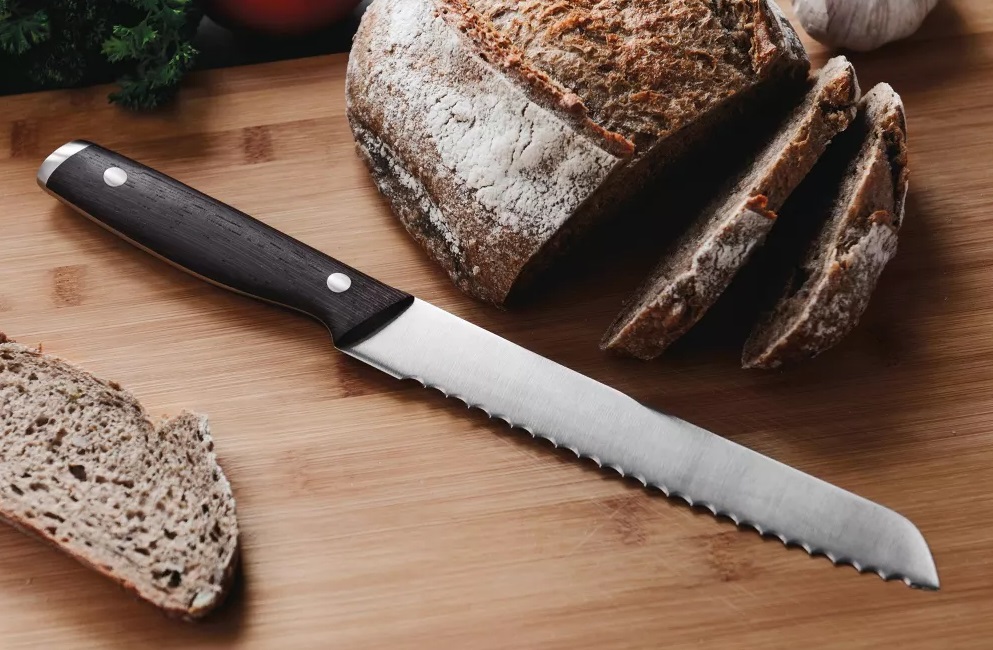
Unlike a straight blade that might squash or deform the crust, a serrated knife cuts through the tough outer layer with ease while preserving the structure. The bread’s crust is pierced by the pointed or scalloped serrations without needlessly compressing it, resulting in slices with attractive and intact crusts.
The precise slicing facilitated by these kitchen knives helps preserve the freshness of bread, this is another reason they are perfect as a bread knife. Clean cuts reduce the surface area exposed to air, minimizing the rate of staling and prolonging the bread’s shelf life.
The proper technique is essential to maximizing the effectiveness of a serrated knife as a bread knife. To guarantee that the teeth grip the crust and slide through the loaf of bread smoothly, use a gentle sawing motion with little downward pressure. Even slices can be achieved by keeping your slicing and angle constant.
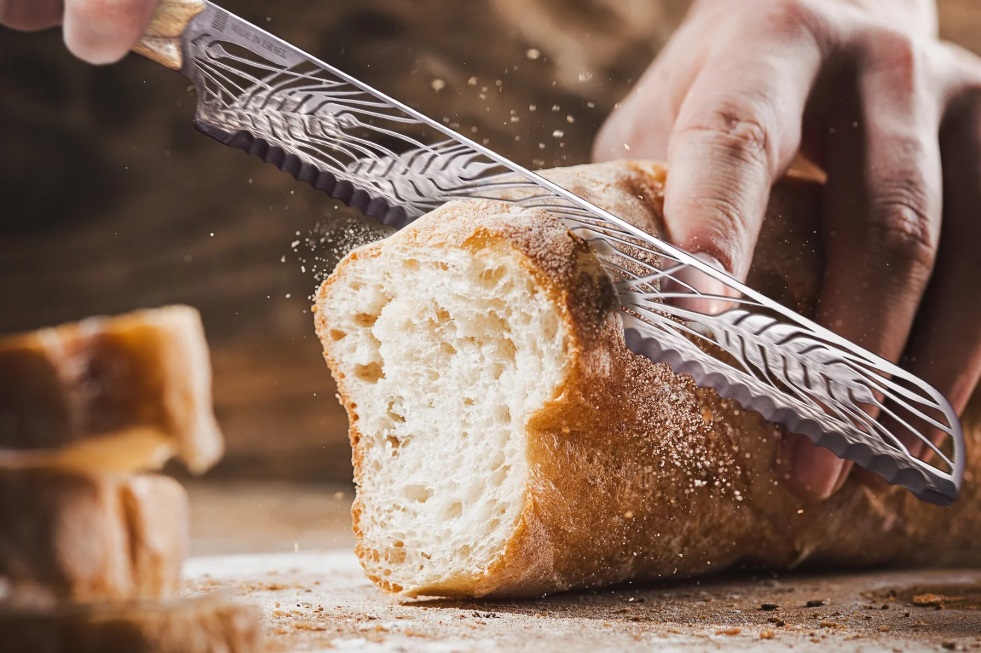
Slicing vegetables and soft fruits
In addition to being an amazing bread knife, a serrated knife can be also used for cutting fruits and vegetables.
It takes skill to cut through delicate fruits like peaches and strawberries or veggies like tomatoes and peppers. When using traditional straight-edged knives, their delicate structures frequently result in squished or unevenly cut pieces.
The saw-like edge of the serrated knife, with its pointed or scalloped teeth, provides a mild yet efficient slicing action. Unlike the chef’s knife or the paring knife, serrated blades grip the skin of vegetables or soft fruits without crushing them. This precision allows for clean, uniform slices while maintaining the delicate structure and texture of the produce.
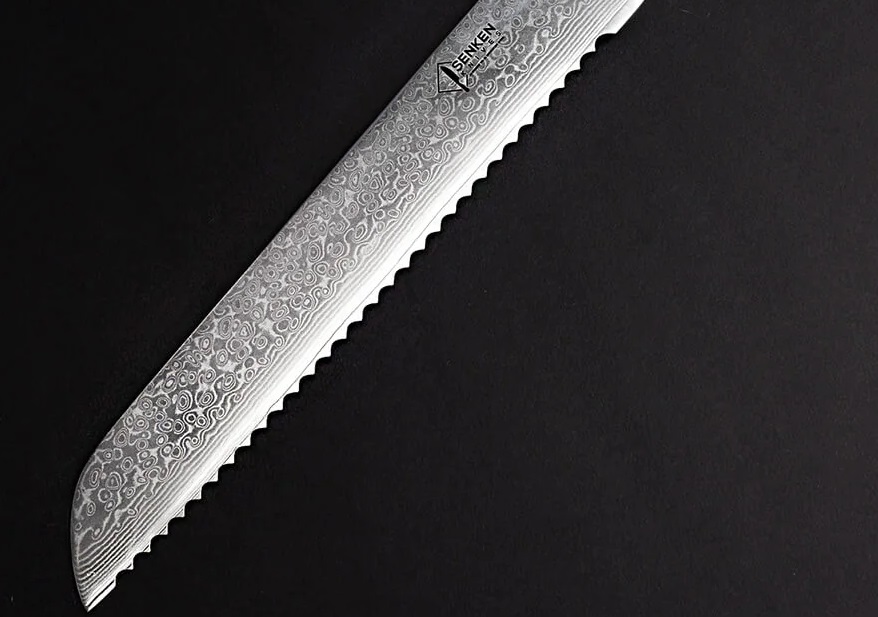
The toothed edge of a serrated knife minimizes the need for forceful downward pressure. Instead, the serrations grip the surface, guiding the knife through the soft pulp with ease. This reduced pressure not only ensures smoother slicing but also grants the user greater control over the cutting motion.
A serrated knife makes it easier to slice vegetables and soft fruits precisely, preserving their freshness and aesthetic appeal. Smooth, even cuts improve the way food looks and help substances last longer on the shelf by limiting their exposure to air.
Serrated knives are effective at handling a variety of textures. Whether slicing through the delicate skin of a ripe tomato or the flesh of a soft peach, the saw-like teeth of a serrated knife handles the surface excellently without causing unnecessary mistakes or loss of juices, ensuring a satisfying cutting and eating experience.
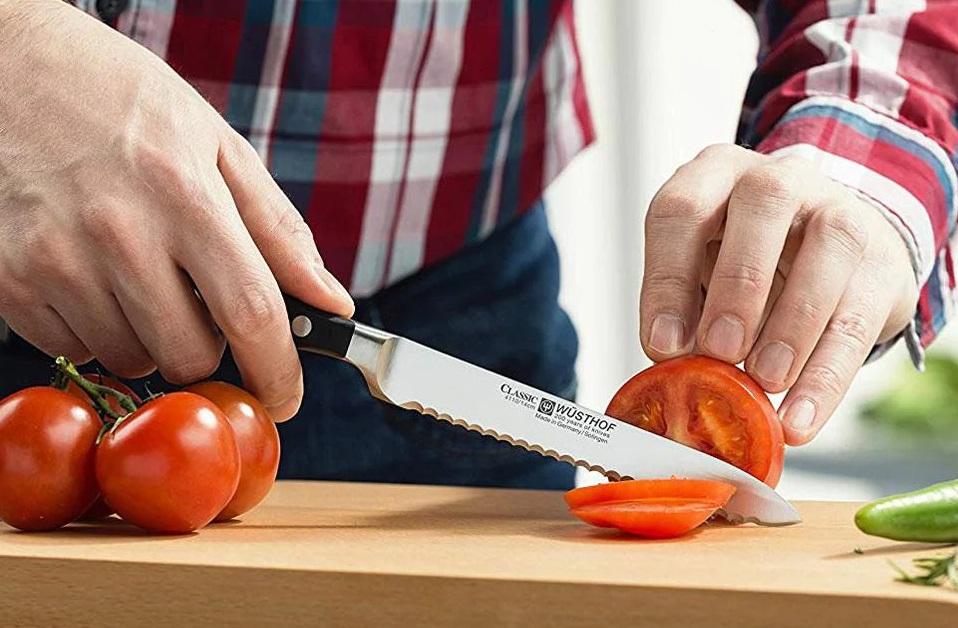
Carving roasts and meats
The different textures and densities of roasts, like beef, poultry, or pork, make carving them challenging. Regular straight-edged knives frequently have trouble cutting meat into neat, accurate slices, which can result in uneven cuts and possibly shred the meat’s fibers.
The edge of these serrated steak knives adapts remarkably well to the diverse textures of different cuts of meat. The serrations hold the meat’s surface in place, allowing for precise slicing actions without sacrificing the structure or moisture content of dense cuts or tender roasts.
These knives’ accurate cutting allows the meat’s juices to be retained, maintaining its flavor and succulence. Even and clean slices prevent natural juices from being lost, keeping every bite juicy and delicious.
The clean, uniform slices achieved with a serrated edge enhance the presentation of carved meats. Whether serving guests or preparing a dish for personal enjoyment, the aesthetic appeal of neatly carved slices adds a touch of culinary finesse to any meal thanks to these steak knives.
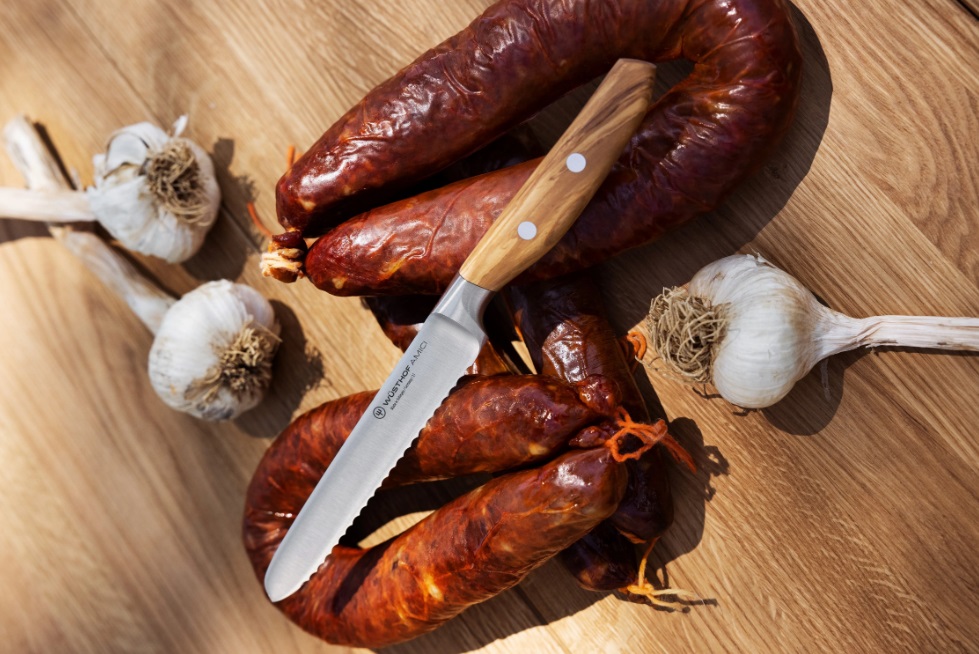
Cake and pastry cutting
If you are a huge fan of cakes or you’re into pastries you need a serrated knife, the teeth of a sharp serrated knife create tiny serrations that let the knife easily cut through layers of cake or pastry, ensuring clean cuts without compromising the delicate fillings or textures.
The knife’s serrated edge reduces friction while cutting, which lessens the chance of ripping or pulling delicate layers. The artistry of the baker’s creation is preserved because each slice of cake or pastry is sliced precisely, maintaining its structural integrity.
The serrated knife stands as an exemplary tool for achieving precision and finesse in cutting cakes and pastries. Its unique edge, combined with the ability to maintain the aesthetics, flavor, and structural integrity of desserts, elevates the act of cutting into an art form.
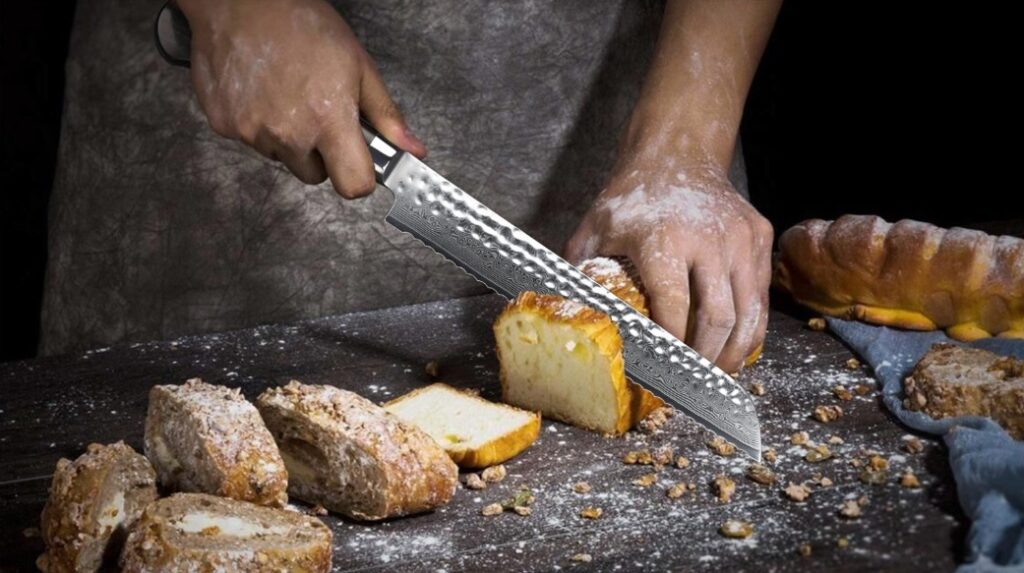
Emergencies
Like the chef’s knife and paring knife, a serrated knife is important in every set of kitchen knives because the saw-like teeth of serrated knives facilitate precise cutting as a utility knife and even in challenging situations. Their ability to grip materials minimizes slippage and ensures controlled and effective cutting in emergencies.
One of the primary uses of serrated blades in emergencies is cutting through ropes, cords, or straps. The saw-like edge of these knives grips the material, allowing for efficient cutting without requiring excessive force.
A serrated blade is very efficient as a utility knife in situations where other knives are not available or accessible.
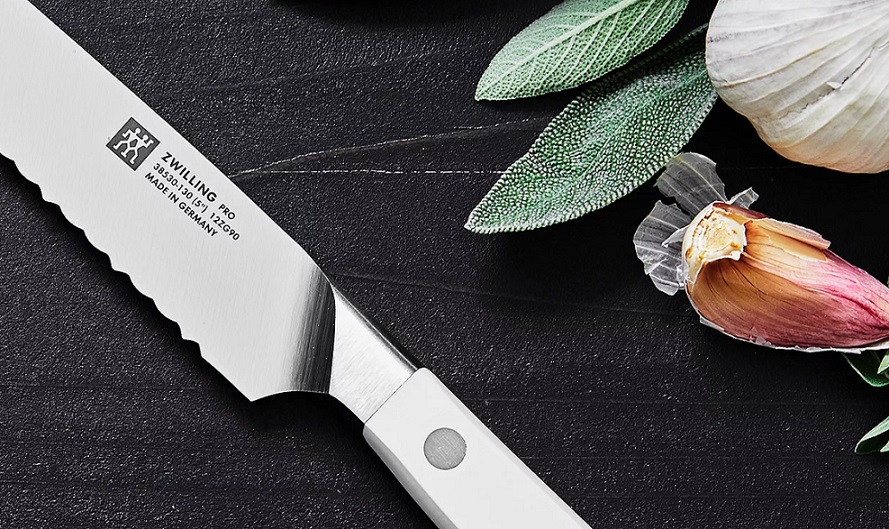
Maintenance tips for serrated knives
- Hand wash. If possible, avoid using a dishwasher as the high heat and harsh detergents can damage the blade and handle.
- Knife block. store serrated knives in a knife block or on a magnetic strip to prevent the dulling from contact with other utensils
- Avoid soaking. Soaking the knife for an extended amount of time could corrode some materials or damage the handle.
- Sharpening. Buy a specialized serrated knife sharpener designed to maintain a unique edge. Sharpen only the flat side of the serrations, maintaining the original angle.
FAQ
What is the purpose of serrated knives?
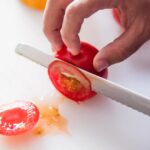
Serrated knives are very versatile tools that serve numerous purposes including cutting vegetables and slicing bread.
When would you use a serrated knife?
A serrated knife is a very effective and versatile kitchen equipment that can be used as steak knives and used for slicing bread.
Can I sharpen serrated knives?

Though they don’t need to be sharpened often like the chef’s knife or other straight-edge knives, serrated knives can be occasionally using a good serrated knife sharpener.
Conclusion
A serrated knife is an important and very versatile tool essential for every cook and kitchen enthusiast. By using this article “What is a serrated knife used for“ as a guide and following safety precautions, you can make amazing dishes and make the most out of your serrated knife.

